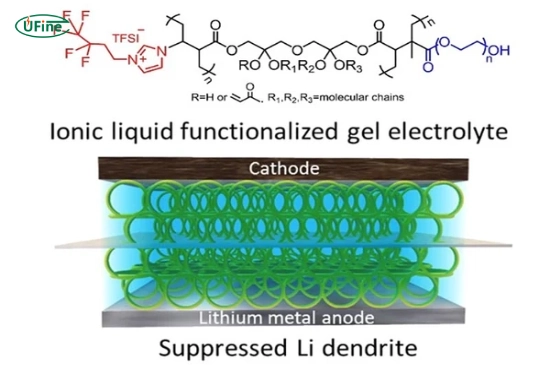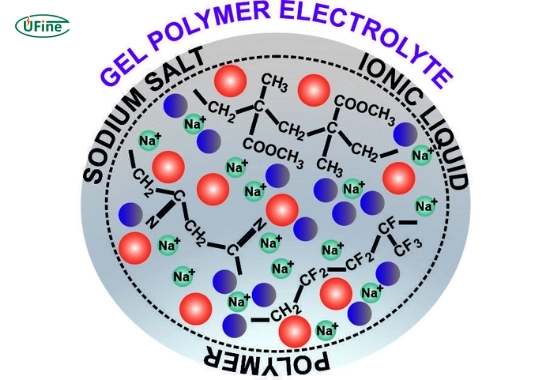Gel polymer electrolytes are changing energy storage and conversion. They offer a unique mix of properties that improve the performance of batteries, fuel cells, and various electronic devices. As the need for safer and more efficient energy solutions grows, understanding gel polymer electrolytes becomes essential. This guide explores their composition, properties, applications, and how they compare to traditional electrolytes. It provides a clear overview for anyone interested in this innovative technology.
Part 1. What are gel polymer electrolytes?
Gel polymer electrolytes are special materials that combine solid and liquid electrolyte features. They consist of a polymer matrix that hosts ions, lithium salt, and a solvent. This mix creates a gel-like consistency that allows for good ionic conductivity while keeping structural integrity.
The polymer matrix is important because it provides support and affects how ions move. The lithium salt dissolves in the solvent, creating a medium for ion movement. This unique structure lets gel polymer electrolytes be customized for specific uses, making them essential in modern energy storage systems.
One key feature of gel polymer electrolytes is their high ionic conductivity, often similar to liquid electrolytes. They also reduce many safety risks. For example, they lower the chances of leakage and flammability, making them a great choice for next-generation batteries.
Part 2. What are the main components of gel polymer electrolytes?
Understanding the main parts of gel polymer electrolytes helps clarify how they work:
- Polymer Matrix: This is usually made from polyvinylidene fluoride (PVDF) or polyethylene oxide (PEO). The type of polymer affects strength and how well ions move.
- Lithium Salt: Common salts include lithium hexafluorophosphate (LiPF6) and lithium bis(trifluoromethanesulfonyl)imide (LiTFSI). These salts dissolve in the solvent to provide mobile lithium ions.
- Solvent: The solvent is often an organic compound like ethylene carbonate or propylene carbonate. It is crucial for dissolving the lithium salt and helping ions move.
These parts work together to create an electrolyte that balances conductivity, safety, and stability.
Part 3. How do gel polymer electrolytes compare to traditional electrolytes?
When comparing gel polymer electrolytes to traditional liquid electrolytes, several key differences emerge:
- Safety: Gel polymer electrolytes are less prone to leakage and combustion than liquid electrolytes, which can be volatile and flammable.
- Ionic Conductivity: While traditional liquid electrolytes generally have higher ionic conductivity at room temperature, advancements in gel polymer formulations have narrowed this gap significantly.
- Mechanical Properties: Gel polymer electrolytes offer enhanced mechanical strength and flexibility, making them suitable for applications requiring lightweight materials.
- Temperature Stability: Gel polymer electrolytes often exhibit better thermal stability than their liquid counterparts, allowing them to function effectively across a more comprehensive temperature range.
Comparison Table
| Property | Gel Polymer Electrolytes | Traditional Liquid Electrolytes |
|---|---|---|
| Ionic Conductivity | 10-3 to 10-2 S/cm | 10-2 to 10-1 S/cm |
| Safety | Low risk of leakage | Higher risk of leakage |
| Mechanical Strength | High | Variable |
| Temperature Stability | Wide range | Limited range |
| Flexibility | High | Low |
Part 4. Properties of gel polymer electrolytes
The properties of gel polymer electrolytes are vital for their performance in different applications:
- Ionic Conductivity: High ionic conductivity is important for efficient ion transport in batteries and fuel cells. Researchers are working to improve this property with new formulations.
- Thermal Stability: Gel polymer electrolytes need to function well across different temperatures to ensure safety and efficiency in energy storage systems.
- Mechanical Strength: A strong mechanical structure helps prevent leaks and damage during operation.
- Electrochemical Stability: It is essential that the electrolyte does not react negatively with electrodes to ensure battery longevity.
- Flexibility: Gel polymer electrolytes can adapt their shapes, allowing them to fit into various device designs. This enhances their usability in modern electronics.
Part 5. Applications of gel polymer electrolytes
The versatility of gel polymer electrolytes has led to their use in many industries:
- Batteries: They are commonly used in lithium-ion batteries because of their better safety and increased energy density.
- Fuel Cells: These electrolytes help ions move between electrodes in fuel cells, improving energy generation efficiency.
- Supercapacitors: Their quick charge-discharge abilities make them ideal for supercapacitors, which need high-performance materials.
- Sensors: The unique properties of gel polymer electrolytes enhance the responsiveness and accuracy of sensors in various applications.
- Medical Devices: Biocompatible formulations allow these electrolytes to be used in medical devices, such as drug delivery systems and biosensors.
Part 6. Advantages of using gel polymer electrolytes
The advantages of gel polymer electrolytes make them more popular:
- Safety: They have a lower risk of leaks and fires, improving overall safety compared to traditional liquid systems.
- Higher Energy Density: These materials allow for compact batteries with greater energy capacity, which is vital for portable devices.
- Flexibility in Design: Their adaptable nature lets manufacturers create innovative designs without sacrificing performance.
- Environmental Friendliness: Many formulations can be made with lower toxicity levels, supporting global sustainability goals.
- Improved Performance: Ongoing research keeps improving gel polymer electrolyte performance, making them a top choice for future energy solutions.
Part 7. Future prospects of gel polymer electrolytes
Looking ahead, the future of gel polymer electrolytes looks bright. As industries shift toward greener and more efficient energy solutions, research will likely focus on improving these electrolytes. Innovations include:
- Nanocomposites: These materials can greatly increase the ionic conductivity of gel polymer electrolytes. This leads to better battery performance.
- Biodegradable Options: Researchers are exploring biodegradable gel polymer electrolytes to reduce environmental impact.
- Integration with Renewable Energy: Combining gel polymer electrolytes with renewable energy sources could enhance energy storage technologies. This would make electricity more accessible and sustainable.
Part 8. FAQs
-
How are gel polymer electrolytes used in batteries?
Batteries enhance ionic conductivity and safety while contributing to more efficient energy storage. -
How do gel polymer electrolytes enhance battery performance?
They improve safety by reducing leakage risks and increasing energy density and thermal stability compared to traditional liquid electrolytes. -
What industries benefit from gel polymer electrolyte technology?
Due to its versatile applications, this technology benefits industries such as consumer electronics, renewable energy, automotive (electric vehicles), and medical devices. -
Can gel polymer electrolytes be environmentally friendly?
Many formulations can be designed with eco-friendly materials that reduce toxicity and environmental impact during production and disposal. -
What future developments can we expect in gel polymer electrolyte technology?
Innovations may include biodegradable options, enhanced ionic conductivities through nanocomposites, and integration with renewable energy systems for improved storage solutions.
Related Tags:
More Articles

White Stuff on Battery Terminals: A Step-by-Step Cleaning and Maintenance Guide
White stuff on battery terminals is corrosion. Learn how to clean it safely, prevent damage, and keep your battery running strong with simple steps.
Understanding How Glass Mat Batteries Work: Technology, Benefits, and Limitations
Glass mat batteries power cars, RVs, and solar systems. Learn how they work, their benefits, and what to consider before choosing one.
A Buyer’s Guide for AA Size Lithium Battery
Discover the power of AA size lithium batteries—types, voltage, capacity, and more! Learn how to choose the best one for your needs. Read now!
Li-Ion Battery Prices – Where to Buy Cheap & Safe
Discover li-ion cell prices, key market factors, and how to find affordable custom batteries from top suppliers like Ufine Battery.
How Long Does a 2200mAh Battery Last?
Discover everything about 2200mAh batteries—types, charging time, lifespan, and whether it’s enough for your device.





